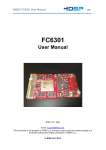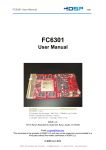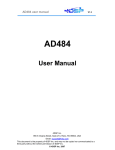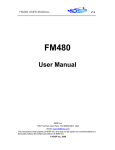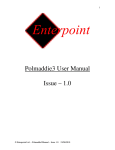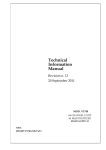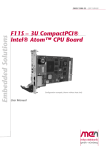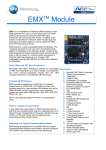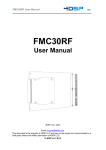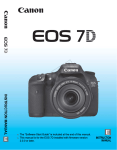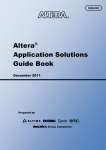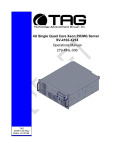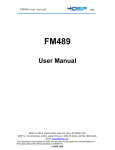Download FM577 User Manual - 4DSP LLC | Data Acquisition and Signal
Transcript
FM577 user manual V1.2 FM577 User Manual 4DSP LLC, 955 S Virginia Street, Suite 214, Reno, NV 89502, USA 4DSP BV, Ondernemingsweg 66f, 2404HN, Alphen aan den Rijn, Netherlands Email: [email protected] This document is the property of 4DSP Inc. and may not be copied nor communicated to a third party without the written permission of 4DSP Inc. © 4DSP 2010 FM577 user manual V1.2 Revision History Date Revision Version 15-04-08 First release 1.0 15-05-08 Updated board images. 1.1 19-05-08 Removed obsolete information 1.1.1 May 12 2009 Changed logo, corrected typos 1.2 May 2010 FM577 User manual www.4dsp.com -2- FM577 user manual V1.2 Table of Contents 1 2 3 4 5 6 7 8 9 Acronyms and related documents ............................................................................. 4 1.1 Acronyms ............................................................................................................... 4 1.2 Related Documents ............................................................................................... 4 1.3 General description ................................................................................................ 5 Installation ................................................................................................................... 6 2.1 Requirements and handling instructions ................................................................ 6 2.2 Firmware and software........................................................................................... 6 Cyclone III features ...................................................................................................... 6 3.1 Series termination .................................................................................................. 6 Design .......................................................................................................................... 6 4.1 FPGA devices ........................................................................................................ 6 4.1.1 FPGA_A device.............................................................................................. 6 4.1.2 FPGA_B device.............................................................................................. 9 4.2 FPGA devices configuration ................................................................................... 9 4.2.1 Flash storage ................................................................................................. 9 4.2.2 CPLD device .................................................................................................10 4.2.3 JTAG .............................................................................................................12 4.3 Clock tree..............................................................................................................12 4.4 Memory resources ................................................................................................13 4.4.1 DDR2 SDRAM ..............................................................................................13 4.5 Front Panel IO daughter card ................................................................................14 4.5.1 Virtex-5 device to I/O front Panel daughter card ............................................14 4.5.2 Power connection to the front panel I/O daughter card ..................................16 Power requirements ...................................................................................................17 5.1 External power connector for stand alone mode ...................................................18 Environment................................................................................................................19 6.1 Temperature .........................................................................................................19 6.2 Convection cooling................................................................................................19 6.3 Conduction cooling ...............................................................................................19 Safety...........................................................................................................................19 EMC .............................................................................................................................19 Warranty ......................................................................................................................19 May 2010 FM577 User manual www.4dsp.com -3- FM577 user manual V1.2 1 Acronyms and related documents 1.1 Acronyms ADC DAC DCI DDR DSP EPROM FBGA FPDP FPGA JTAG LED LVTTL LVDS LSB LVDS MGT MSB PCB PCI PCI-e PLL PMC QDR SDRAM SRAM Analog to Digital Converter Digital to Analog Converter Digitally Controlled Impedance Double Data Rate Digital Signal Processing Erasable Programmable Read-Only Memory Fineline Ball Grid Array Front Panel Data Port Field Programmable Gate Array Join Test Action Group Light Emitting Diode Low Voltage Transistor Logic level Low Differential Data Signaling Least Significant Bit(s) Low Voltage Differential Signaling Multi-Gigabit Transceiver Most Significant Bit(s) Printed Circuit Board Peripheral Component Interconnect PCI Express Phase Locked Loop PCI Mezzanine Card Quadruple Data rate Synchronous Dynamic Random Access memory Synchronous Random Access memory Table 1: Glossary 1.2 Related Documents • IEEE Std 1386.1-2001: IEEE Standard Physical and Environmental Layers for PCI Mezzanine Cards (PMC). PCI Special Interest Group (PCI SIG) PCI Local Bus Specification, Revision 3.0 • • • • ANSI/VITA 20-2001 : Conduction Cooled PMC. ANSI/VITA 42.0-2005: XMC Switched Mezzanine Card Auxiliary Standard. IEEE Std 1386-2001: IEEE Standard for a Common Mezzanine Card (CMC) Family. Altera Cyclone III Device Handbook, Volume 1 and 2 • May 2010 FM577 User manual www.4dsp.com -4- FM577 user manual 1.3 V1.2 General description The FM577 is a high performance PMC, optionally conduction cooled, dedicated to digital signal processing applications with high bandwidth and complex algorithms requirements. It offers multiple interfaces, fast on-board memory resources, and two Altera Cyclone III FPGA devices. It can be utilized, for example, to accelerate frequency-domain algorithms with offthe-shelf Intellectual Property cores for applications that require the highest level of performances. The FM577 is mechanically and electrically compliant to the standard and specifications listed in section 1.2 of this document. Optional Front Panel IO daughter card Video, A/D, D/A, LVDS, Ethernet, etc Optionally conduction cooled 114 DDR2 SDRAM 800MB/s DDR2 SDRAM 800MB/s Up to 512MB Up to 512MB DDR2 SDRAM DDR2 SDRAM 800MB/s 800MB/s EP3C120 Up to 512MB Up to 512MB EP3C40 SMA External clock output FBGA 780 Configuration circuit and JTAG SMA FPGA B 1PPS input or external clock input LED x4 clocks 86 SMA External clock input Flash 128Mbit LED Voltage and temperature monitoring EP3C40 x4 EP3C16 FBGA 484 FPGA A 64 single ended or 30 LVDS pairs Pn1 Pn2 Pn3 Pn4 User I/O PCI 66/33MHz 64/32-bit Figure 1: FM577 block diagram May 2010 FM577 User manual www.4dsp.com -5- FM577 user manual V1.2 2 Installation 2.1 Requirements and handling instructions The FM577 must be installed on a motherboard compliant to the IEEE Std 1386-2001 standard for 3.3V PMC Do not flex the board Observe SSD precautions when handling the board to prevent electrostatic discharges. Do not install the FM4577 while the motherboard is powered up. • • • • 2.2 Firmware and software Drivers, API libraries and a program example working in combination with a pre-programmed firmware for both FPGAs are provided. The FM577 is delivered with an interface to the PCI core in the FPGA_A device and an example VHDL design in the FPGA_B device so users can start performing high bandwidth data transfers over the PCI bus right out of the box. For more information about software installation and FPGA firmware, please refer the FM577 Get Started Guide. 3 Cyclone III features The Cyclone III devices offer features that simplify the PCB layout and improve signal integrity. 3.1 Series termination Cyclone III devices support on-chip series termination with calibration in all banks. The onchip series termination calibration circuit compares the total impedance of the I/O buffer to the external resistors (50 ohms) connected to the RUP and RDN pins, and dynamically adjusts the I/O buffer impedance until they match. This ensures limited reflections on the data lines and better signal integrity. This feature will be used for the Pn4 interface as well as for the PCI bus and the inter-FPGA bus. 4 Design 4.1 FPGA devices The FPGA_A and FPGA_B FPGA devices interface to the various resources on the FM577 as shown on Figure 1. They also interconnect to each other via 82 general purpose pins and 4 clock pins (2 pairs, one in each direction, optionally 100Ω terminated). 4.1.1 4.1.1.1 FPGA_A device Cyclone III device family and package The FPGA_A device is from the Altera Cyclone III family. It can be an EP3C40 in a Fineline Ball Grid array package with 484 balls. May 2010 FM577 User manual www.4dsp.com -6- FM577 user manual 4.1.1.2 V1.2 PCI interface The FPGA_A device interfaces directly to the PCI bus via the PMC Pn1, Pn2 and Pn3 connectors. An embedded PCI core from Altera is used to communicate over the PCI bus with the host system on the motherboard. PCI 64-bit 66MHz, PCI 64-bit 66MHz and PCI 32bit 33MHz are supported on the FM577. The bus type must be communicated at the time of the order so the right FPGA_A device firmware can be loaded into the flash prior to delivery. The following performances have been recorded with the FM577 transferring data on the bus: PCI 64-bit 66MHz: TBD PCI 32-bit 33MHz: TBD 4.1.1.3 LED Four LEDs are connected to the FPGA_A device. In the default FPGA firmware, the LEDs are driven by the FPGA_B device via the inter-FPGA interface. The LEDs are located on side 2 of the PCB in the front panel area. FPGA_LED[3] FPGA_LED[2] FPGA_LED[1] FPGA_LED[0] Figure 2: FPGA LED locations May 2010 FM577 User manual www.4dsp.com -7- FM577 user manual 4.1.1.4 V1.2 Pn4 user I/O connector The Pn4 connector is connected to the FPGA_A device. All 64 signals can be used as single ended and Cyclone III series termination can be implemented. 3.3V, 2.5V or 1.8V signalling is available (3.3V by default is mounted on board). Optionally LVDS signalling is available on 30 pairs, in which case the FPGA banks voltage must be set to 2.5V. The length skew between any two data lines will not exceed 50mm. The following table gives the FPGA A pin assignment for the Pn4 signals. Connector pin 1 3 5 7 9 11 13 15 17 19 21 23 25 27 29 31 33 35 37 39 41 43 45 47 49 51 53 55 57 59 61 63 May 2010 Signal name Pn4_IO0 Pn4_IO2 Pn4_IO4 Pn4_IO6 Pn4_IO8 Pn4_IO10 Pn4_IO12 Pn4_IO14 Pn4_IO16 Pn4_IO18 Pn4_IO20 Pn4_IO22 Pn4_IO24 Pn4_IO26 Pn4_IO28 Pn4_IO30 Pn4_IO32 Pn4_IO34 Pn4_IO36 Pn4_IO38 Pn4_IO40 Pn4_IO42 Pn4_IO44 Pn4_IO46 Pn4_IO48 Pn4_IO50 Pn4_IO52 Pn4_IO54 Pn4_IO56 Pn4_IO58 Pn4_IO60 Pn4_IO62 FPGA pin FPGA pin FM577 User manual www.4dsp.com Signal name Pn4_IO1 Pn4_IO3 Pn4_IO5 Pn4_IO7 Pn4_IO9 Pn4_IO11 Pn4_IO13 Pn4_IO15 Pn4_IO17 Pn4_IO19 Pn4_IO21 Pn4_IO23 Pn4_IO25 Pn4_IO27 Pn4_IO29 Pn4_IO31 Pn4_IO33 Pn4_IO35 Pn4_IO37 Pn4_IO39 Pn4_IO41 Pn4_IO43 Pn4_IO45 Pn4_IO47 Pn4_IO49 Pn4_IO51 Pn4_IO53 Pn4_IO55 Pn4_IO57 Pn4_IO59 Pn4_IO61 Pn4_IO63 Connector pin 2 4 6 8 10 12 14 16 18 20 22 24 26 28 30 32 34 36 38 40 42 44 46 48 50 52 54 56 58 60 62 64 -8- FM577 user manual V1.2 Table 2 : Pn4 pin assignment 4.1.2 FPGA_B device 4.1.2.1 Cyclone III device family and package The FPGA_B device is dedicated to Digital Signal Processing applications. This Altera Cyclone III device can be either an EP3C120 in a Fineline Ball Grid array package with 780 balls. 4.1.2.2 Cyclone III device external memory interfaces The FPGA_B device interfaces up to four 128Mbytes DDR2 SDRAM bank. A maximum performance of up to 800MB/s per DDR2 SDRAM bank can be achieved. 4.1.2.3 Cyclone III device interface to Front Panel daughter card The FPGA_B device interfaces to the front panel daughter card on the FM577 via a high speed connector. 114 I/Os are available from the FPGA to/from the daughter card. Refer to the Front Panel I/O section of this document for more details about the daughter card connector electrical characteristics. 4.2 FPGA devices configuration 4.2.1 Flash storage The FPGA firmware is stored on board in a flash device. The 512Mbit device is partly used to store the configuration for both FPGAs. In the default CPLD firmware configuration, the Cyclone III device A and B are directly configured from flash if a valid bitstream is stored in the flash for each FPGA. The flash is pre-programmed in factory with the default firmware example for both FPGAs. May 2010 FM577 User manual www.4dsp.com -9- FM577 user manual V1.2 Figure 3 : Configuration circuit 4.2.2 CPLD device As shown on Figure 2, a CPLD is connected between the flash device and the FPGA devices. The CPLD main function is to program and read the flash. The data stored in the flash are transferred from the host motherboard via the PCI bus to the FPGA_A device and then to the CPLD writes the required bit stream to the storage device. A 31.25 MHz clock connects to the CPLD and is used to generate the configuration clock sent to the FPGA devices. At power up, if the CPLD detects that an FPGA configuration bitstream is stored in the flash for both FPGA devices, it will start programming the devices. Do NOT reprogram the CPLD without 4DSP approval The CPLD configuration is achieved by loading with an Altera download cable a bitstream from a host computer via the JTAG connector. The FPGA devices configuration can also be performed using the JTAG. 4.2.2.1 DIP Switch A switch (J1) is located next to the JTAG programming connector see Figure 4. The switch positions are defined as follows: May 2010 FM577 User manual www.4dsp.com - 10 - FM577 user manual V1.2 Figure 4: switch (J1) location Sw1 OFF Default setting. The Cyclone III device configuration is loaded from the flash at power up. ON Cyclone III device safety configuration loaded from the flash at power up. To be used only if the Cyclone III device cannot be configured or does not perform properly with the switch in the OFF position. Sw2 Reserved Sw3 Reserved Sw4 Reserved Table 3: Switch description 4.2.2.2 LED and board status Four LEDs connect to the CPLD and give information about the board status. LED 0 LED 1 LED 2 LED 3 LED 3 Flashing FPGA A or B bitstream or user_ROM_register is currently being written to the flash ON FPGA A not configured OFF FPGA A configured Flashing FPGA A or B bitstream or user_ROM_register is currently being written to the flash ON FPGA B not configured OFF FPGA B configured Flashing The FPGA_A device has been configured with the safety configuration bitstream programmed in the flash at factory. Please write a valid FPGA_A device bitstream to the flash. ON Flashn is busy writing or erasing OFF Flash device is not busy ON CRC error. Presumably a wrong or corrupted FPGA bitstream has been written to the flash. Once on this LED remains on OFF No CRC error detected Table 4: LED board status May 2010 FM577 User manual www.4dsp.com - 11 - FM577 user manual V1.2 CPLD_LED[0] CPLD_LED[1] CPLD_LED[2] CPLD_LED[3] Figure 5: CPLD LED locations 4.2.3 JTAG A JTAG connector is available on the FM577 for configuration purposes. The JTAG can also be used to debug the FPGA design with the Altera Signal Tap. The JTAG connector is located on side 1 of the PCB (see Figure 6). Figure 6: JTAG connector location The JTAG connector pinout is as follows: Pin # 1 2 3 Signal 2.5V GND TCK Signal TMS TDI TDO Pin # 4 5 6 Table 5 : JTAG pin assignment 4.3 Clock tree The FM577 clock architecture offers an efficient distribution of low jitter clocks. May 2010 FM577 User manual www.4dsp.com - 12 - FM577 user manual • • • V1.2 Both FPGA devices and the CPLD receive a low jitter 50MHz clock. A low jitter programmable clock able to generate frequencies from 16MHz to 230MHz in steps of 0.5MHz is connected to both FPGA devices Two external input clocks and one output clock are available via the front panel with SMA connectors. These external clocks are single ended LVCMOS. This clock management approach ensures maximum flexibility to efficiently implement multi-clock domains algorithms and use the memory devices at different frequencies. The frequency synthesizer (CDCEL925) is controlled by the FPGA_A device. Figure 7 : Clock tree 4.4 Memory resources 4.4.1 DDR2 SDRAM Four independent 16-bit DDR2 SDRAM banks are connected to FPGA B. Each bank provides 128Mbytes. In total a maximum of 512Mbytes of DDR2 SDRAM are available on board. These memory resources can be used by the FPGA logic as data buffers during signal processing. May 2010 FM577 User manual www.4dsp.com - 13 - FM577 user manual 4.5 4.5.1 V1.2 Front Panel IO daughter card Cyclone 3 device to I/O front Panel daughter card (Only available with daughter card purchase) The FPGA B interfaces to a 120-pin connector placed in the Front panel I/O area (on both side 1 and side 2 of the PCB). It serves as a base for a daughter card and offers I/O diversity to the FM577 PMC. On side 2 of the PCB, the connectors and mounting holes placement complies with the SLB standard. The FPGA I/O banks are powered either by 1.5V, 2.5V or 3.3V via large 0 ohms resistors (3.3V is the default if not specified otherwise at the time of order). Please, contact 4DSP Inc. for more information about the daughter card types available. The 120-pin Samtec connector pin assignment is as follows. The pins are grouped in LVDS pairs (FP_Px and FP_Nx). All signals that are shown as LVDS pairs in the table can be used for any standard that is not in breach the Altera I/O pad electrical. Connector pin 1 3 5 7 9 11 13 15 17 19 21 23 25 27 29 31 Signal Name FP_P0 FP_N0 FP_P2(2) FP_N2(2) FP_P4 FP_N4 FP_P6 FP_N6 FP_P8 FP_N8 FP_P10(2) (2) FP_N10 FP_P12 FP_N12 FP_P14 FP_N14 33 35 37 39 FPGA pin FPGA pin Signal name FP_P1 FP_N1 FP_P3 FP_N3 FP_P5 FP_N5 FP_P7 FP_N7 FP_P9 FP_N9 FP_P11 FP_N11 FP_P13 FP_N13 FP_P15 FP_N15 Connector pin 2 4 6 8 10 12 14 16 18 20 22 24 26 28 30 32 FP_P16(2) FP_P17(1) 34 (2) (1) 36 FP_N16 FP_N17 (1) FP_P19 38 (1) FP_N19 40 FP_P18 FP_N18 Table 6 : Front Panel IO daughter card pin assignment Bank A (1) (2) Connected to a global clock pin on the FPGA. Connected to a regional clock pin on the FPGA. May 2010 FM577 User manual www.4dsp.com - 14 - FM577 user manual Connector pin 41 43 45 47 49 51 53 55 57 59 61 63 65 67 69 71 73 75 77 79 81 83 85 87 89 91 93 95 97 99 101 103 105 107 109 111 113 115 117 119 Differential FP_P20 FP_N20 FP_P22 FP_N22 FP_P24(2) (2) FP_N24 FP_P26 FP_N26 FP_P28 FP_N28 FP_P30 FP_N30 FP_P32 FP_N32 FP_P34 FP_N34 FP_P36(2) 3.3V/2.5V/1.8V 3.3V/2.5V/1.8V 3.3V/2.5V/1.8V FP_P37 FP_N37 FP_P39 FP_N39 FP_P41 FP_N41 FP_P43 FP_N43 (1) FP_P45 FP_N45(1) FP_P47 FP_N47 FP_P49 FP_N49 FP_P51 FP_N51 FP_P53(2) FP_N53(2) FP_P55(1) (1) FP_N55 V1.2 FPGA pin FPGA pin Differential FP_P21 FP_N21 FP_P23 FP_N23 FP_P25 FP_N25 FP_P27 FP_N27 FP_P29 FP_N29 FP_P31 FP_N31 FP_P33 FP_N33 (2) FP_P35 FP_N35(2) FP_N36(2) Vbatt 0.9V 3.3V/2.5V/1.8V FP_P38 FP_N38 FP_P40 FP_N40 FP_P42 FP_N42 FP_P44 FP_N44 FP_P46 FP_N46 FP_P48 FP_N48 FP_P50 FP_N50 FP_P52 FP_N52 FP_P54 FP_N54 FP_P56 FP_N56 Connector pin 42 44 46 48 50 52 54 56 58 60 62 64 66 68 70 72 74 76 78 80 82 84 86 88 90 92 94 96 98 100 102 104 106 108 110 112 114 116 118 120 Table 7: Front Panel IO daughter card pin assignment Banks B and C (1) (2) Connected to a global clock pin on the FPGA. Connected to a regional clock pin on the FPGA. May 2010 FM577 User manual www.4dsp.com - 15 - FM577 user manual V1.2 4.5.2 Power connection to the front panel I/O daughter card The Front Panel I/O daughter card on side 1 of the PCB is powered via a 7-pin connector of type BKS (Samtec). Each pin can carry up to 1.5A. The power connector’s pin assignment is as follows. Pin # 1 3 5 7 Signal +3.3V +5V +12V -12V Signal +3.3V GND GND Pin # 2 4 6 Table 8: Daughter card power connector pin assignment on PMC side 1 On side 2 of the PCB, the daughter card is powered via a 33-pin connector of type BKS (Samtec). Each pin can carry up to 1.5A. The power connector’s pin assignment is as follows. Pin # 1 3 5 7 9 11 13 15 17 19 21 23 25 27 29 31 33 Signal +3.3V +3.3V +3.3V +3.3V +5V +5V +5V +5V +12V +12V -12V -12V GND reserved reserved reserved GND Signal GND GND GND GND GND GND GND GND GND GND GND GND reserved reserved reserved reserved Pin # 2 4 6 8 10 12 14 16 18 20 22 24 26 28 30 32 Table 9: Daughter card power connector pin assignment on PMC side 2 May 2010 FM577 User manual www.4dsp.com - 16 - FM577 user manual V1.2 5 Power requirements The Power is supplied to the FM577 via the PMC. Several DC-DC converters generate the appropriate voltage rails for the different devices and interfaces present on board. The FM577 power consumption depends mainly on the FPGA devices work load. By using high efficiency power converters, all care has been taken to ensure that power consumption will remain as low as possible for any given application. After power up the FM577 typically consumes 2W of power. For precise power measurements it is recommended to use the Altera power estimation tools for both the Cyclone III FPGA devices. The maximum current rating given in the table below is the maximum current that can be drawn from each voltage rail in the case resources are used to their maximum level. Device/Interface Voltage Maximum current rating 0.9V 100mA FPGA A & B device core 1.2V 14A DDR2 SDRAM core and I/O banks, FPGA A & B devices I/O banks 1.8V 8A FPGA_A device I/O bank connected to the PCI bus, Flash, CPLD, front Panel I/O daughter card 3.0V/3.3V 3A Front Panel IO daughter card 5V 1A Front Panel IO daughter card 12V 0.5A Front Panel IO daughter card -12V 0.5A Vref and memory reference voltage devices Table 10 : Power supply Optionally, the FM577 can be used as a stand alone module and is powered via the external power connector. May 2010 FM577 User manual www.4dsp.com - 17 - FM577 user manual V1.2 Figure 8 : Power supply An ADT7411 device is used to monitor the power on the different voltage rails as well as the temperature. The ADT7411 data are constantly passed to the Cyclone-III device. Measurements can be accessed from the host computer via the PCI bus. A software utility delivered with the board allows the monitoring of the voltage on the 2.5V, 1.8V, 1.5V, 1.0V and 0.75V rails. It also displays both FPGAs junction temperature. 5.1 External power connector for stand alone mode An external power connector (J2) is available on side 2 of the PMC, next to the PMC connectors. It is used to power the board when it is in stand alone mode. This is a right angled connector and it will be mounted on board only if the card is ordered as a stand alone version (FM577-SA). The height and placement of this connector on the PCB breaches the PMC specifications and the module should not be used in an enclosed chassis compliant to PMC specifications if the external power connector is present on board. Do not connect an external power source to J2 if the board is powered via the PMC connectors. Doing so will result in damaging the board. The external power connector is of type Molex 43045-1021. Each circuit can carry a maximum current of 5A. The connector pin assignment is as follows: Pin # 1 3 5 7 9 Signal 3.3V 5V GND GND -12V Signal 3.3V 5V GND GND 12V Pin # 2 4 6 8 10 Table 11 : External power connector pin assignment May 2010 FM577 User manual www.4dsp.com - 18 - FM577 user manual V1.2 6 Environment 6.1 Temperature Operating temperature • 0°C to +60°C (Commercial) • -40°C to +85°C (Industrial) Storage temperature: • -40°C to +120°C 6.2 Convection cooling 300LFM minimum 6.3 Conduction cooling The FM577 can optionally be delivered as conduction cooled PMC compliant to ANSI/VITA 20-2001 standard for conduction cooled PMC. 7 Safety This module presents no hazard to the user. 8 EMC This module is designed to operate from within an enclosed host system, which is build to provide EMC shielding. Operation within the EU EMC guidelines is not guaranteed unless it is installed within an adequate host system. This module is protected from damage by fast voltage transients originating from outside the host system which may be introduced through the system. 9 Warranty Hardware Software/Firmware Basic Warranty (included) 1 Year from Date of Shipment 90 Days from Date of Shipment Extended Warranty (optional) 2 Years from Date of Shipment 1 Year from Date of Shipment May 2010 FM577 User manual www.4dsp.com - 19 - FM577 user manual V1.2 10 FM577 image May 2010 FM577 User manual www.4dsp.com - 20 -





















